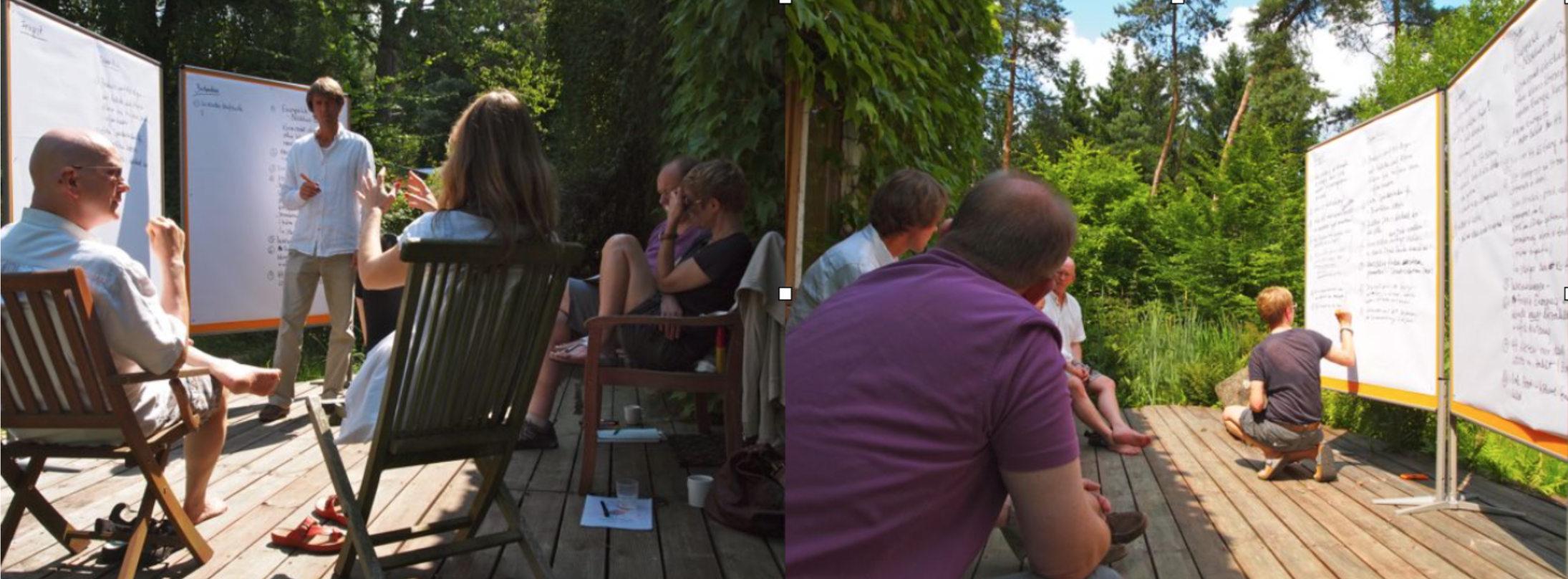
DYNAMIC FACILITATION
Exploring Dynamic Facilitation…
1. What Is It?
2. The Story
3. How It Works
4. Additional Resources
What Is It?
As described in Participedia, Dynamic Facilitation is “a specific form of working with groups that helps participants engage creatively with divergent perspectives.”
Dynamic Facilitation is a key element in the Vorarlberg Bürgerrat model, a format that “addresses community issues in a relatively brief and inexpensive manner” by means of a “facilitated creative exploration.”
Next…The Story
Dynamic Facilitation and
Wiser Democracies:
The story of CII’s role in this work,
and how DF has spread in German-speaking countries…
Tom Atlee first encountered Dynamic Facilitation (DF) in 1999, when he traveled to Port Townsend, WA to attend a seminar led by Jim Rough and his late wife, Jean Rough. Tom was so intrigued by this experience that in the spring of 2000, he returned for another seminar, this time bringing several activist friends with him.
One of the early articles that Tom wrote about DF caught the eye of Matthias zur Bonsen, a German consultant with significant expertise in emergence-based processes. Matthias invited Jim Rough to teach in Germany in 2005, and continued to do so for several years. Now Matthias regularly teaches Dynamic Facilitation seminars in Germany, and has been a key contributor to the spread of this practice among consultants to the business, non-profit, and public sectors.
The seminar in the spring of 2000 was a transformative experience for several of us, including Rosa Zubizarreta, who has been practicing, teaching, researching and writing about Dynamic Facilitation ever since.
As process geeks, all of us at CII were very excited by our initial experiences with Dynamic Facilitation. Even with many broken links and expired email addresses, this archival page from our old website captures some of the energy from that time.
The plot thickens…. Manfred Hellrigl was one of the participants at an early seminar with Jim that Matthias zur Bonsen organized in Germany. Manfred was the director of the Büro für Zukunftsfragen, a small state-level department responsible for sustainability and public engagement in the state of Vorarlberg, Austria. Thus, he had prior experience with Planning Cells, Citizens’ Juries, and a host of other processes.
Along with his dedicated colleagues and staff, Manfred began to experiment with Jim’s DF-powered Wisdom Council Process. The Büro adapted and modified this format, renaming it the “BürgerRat” or “Citizens’ Council”. Their early experiments were quite successful, leading them to continue experimenting with and adapting this model.
Fast-forward to 2020: an OECD report on Innovative Citizen Participation and New Democratic Institutions includes the DF-powered Citizen Councils in Vorarlberg, as one of twelve featured models for deliberative mini-publics. These Councils had been institutionalized in the State of Vorarlberg in 2014. This cost-effective model has also spread to other parts of Austria, Germany, and Switzerland.
The potential Tom saw early on in Jim’s Wisdom Council model, and which led him to attend his first Dynamic Facilitation seminar, is now an on-the-ground phenomenon. While some (including Jim Rough) do not like the term “deliberation”, Rosa’s take on it is that everything evolves, and DF is a lovely form of what she calls “agile deliberation”.
Next…How It Works
How It Works
The Shortish Version Tom has created his own “longish elevator speech” on DF, which he credits as being inspired by Rosa’s masters’ thesis. In it, he highlights:
1. The power of reflective listening, combined with
2. Recording participants’ contributions on the 4 charts, which
3. Helps people “open up” - feel heard, relax and get curious - while exposing the actual complexity of the issue, in order to
4. Gently expand participants’ preconceived notions, and begin to create a shared understanding of the bigger picture.
Sooner or later, the energy shifts into choice-creating, usually when someone says something like “wait a minute! what if we….”
5. At this point, the facilitator steps back and focuses on keeping up with the chart pads, as people talk excitedly with one another.
6. Every so often, they invite a pause to reflect back the last 4-5 contributions, while also stepping in (acupuncture-like) whenever the edge of critique threatens to disrupt the creative flow…
7. Welcoming and redirecting the energy of contestation with something like “what’s your concern? Give it to me…,” a powerful Aikido-like way to re-establish psychological safety and creative flow.
The above process leads people to shift from their original separate stories about the situation into collective sense-making, trying to “solve the shared puzzle” they’ve generated together.
Their collective effort to make sense of the actual situational complexity leads naturally to breakthroughs.
There are a few other factors, of course… a strong solution-oriented component (Tom calls this “solutionizing”) where the question of “what do you think should happen?” is frequently posed to individual participants. And at times, the facilitators may review the chart pads, offering a summary reflection to the group as a whole…
Yet what fascinates Tom the most, is how all this combines synergistically to “evoke a co-creative group mind”. (A term Rosa would hesitate to use, “group mind” being the subject of much academic controversy… :-)
The longer version: Tom’s ”go-to reference” is an abridged version of Rosa’s recent essay that he adapted and posted on his blog site.
Next…Additional Resources
Additional Resources
Explore “Listening Across Differences”, a peer-reviewed article in the Journal of Awareness-Based Systems Change.
Check out the English-language version of the Buergerrat.net website, chock-full of helpful resources.
Read more of Rosa’s writings on Dynamic Facilitation and its various applications.


